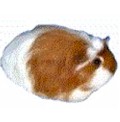Guinea pigs originated from the Andean region of South America, presently known as Ecuador, Bolivia, and Peru. They were a food source for mountain tribes around the year 2000BC. They are still to this day used as a food source in that area. They also live off of families scraps and are used as pets or collectors of evil-spirits in healing ceremonies. European trades transported quinea pigs to Europe, people saw them as exotic pets.
Where do Guinea Pigs get their name and why?No one knows for sure just how the guinea pig came to be called a "pig". They really are not pigs but are larger rodents. However they do tend to make noises that are very similar to that of a pig. They also have some similar physical features with a pig. Their heads are large, with a rounded hind end, and with no tail. The guinea pig is also able to survive in cramped conditions such as a "pig pen" therefore they were easier to transport to England. Even in other languages they are referred to as pigs. The Dutch often called them "Guineas Biggetie" (Guinean piglet). In Germany they use the term "Meerschweinchen" (little sea pigs). The Germans gave the guinea pigs the name from when they would stop in the New World to stock up on provisions and would purchase large amounts of guinea pigs for their main source of meat.
What kind of environment do Guinea Pigs live in?Guinea pigs are very social animals living in large groups consisting of sows (females) and boars (males), the offspring are called pups. Their life expectance is any where from four to eight years. In the year 1997 it was recorded that a guinea pig lived for a record of 15 years. Guinea pigs mate for life unlike similar rodents who have several different mates. Domesticated guinea pigs generally are kept in groups of two, either all females, all males, or one female with a neutered male. All male groups usually do well as long as there is no females brought into their environment and they have enough room in their cage.
When in the wild they can be found in little groups grazing grass a lot like a herd of cattle. They are more active during dawn and dusk making in harder for predators to see them. When the are frightened they can move surprisingly fast. Domestic guinea pigs are often more active for longer periods of time and taking little naps in between.
Domestic guinea pigs usually are kept in plastic cages with softwood chip bedding. They are kept indoors, they are not capable of handling exposure to the elements or predators.
